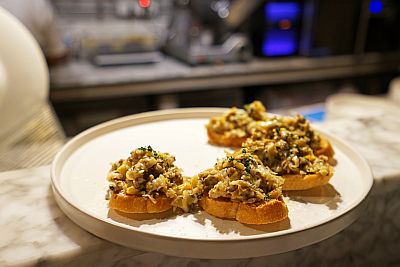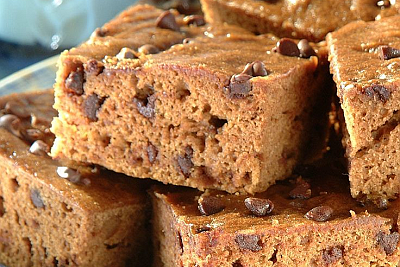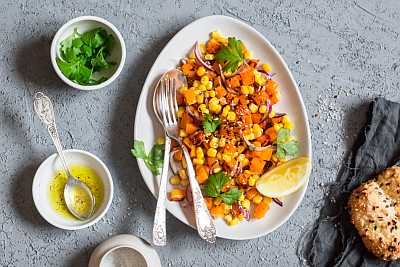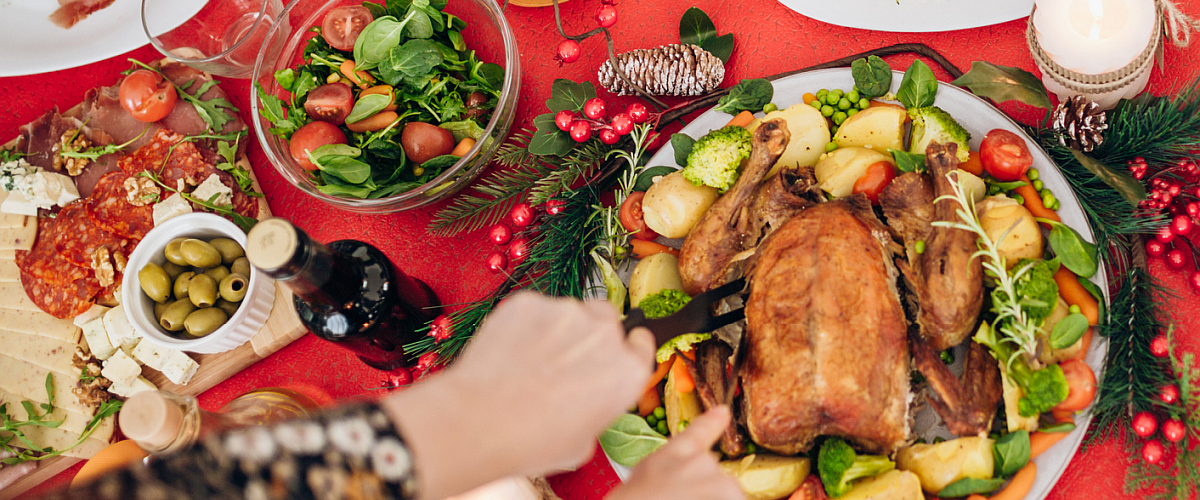The holidays aren’t the holidays without good food, and plenty of it. But many of us become overwhelmed trying to pull together an elaborate meal – especially when we’re also trying to be more health conscious.

If you’re drowning in recipe ideas and shopping lists, try thinking like a chef! We called on Chef Michael Wilson, a Regional Culinary Director with Aramark, for some surefire strategies to pull off a holiday menu that’s both delicious and better for you.
STEP 1: PLANNING
Planning is a critical step in any meal, and Chef Michael would know. He oversees menu development, culinary innovation and more for his team of chefs in Aramark’s Higher Education division. As he puts it, “A meal is a story, one you need to develop.” (We love that!) Here’s how to plan like a pro.
Cover your bases: Make sure your meal plan includes salty, sweet, sour, and spicy flavor profiles. “Be brave!” Chef Michael encourages. “Put enough herbs and seasoning into your dishes, and you’ll lure everyone in through sight, smell, and taste.”

Entice with appetizers: For many families, the holiday meal actually begins with an hour or two of snacking. Chef Michael recommends starting out with an assortment of vegetables, crisps, and spreads. Homemade hummus and guacamole are quick to make, but his personal favorite is a dip using fresh clams, herbs, pecorino cheese, and olive oil. “This gets your guests snacking in a healthy way and takes the pressure off of the heavier main course,” he explains.
Give sides some love: Lots of us focus on a large roast or casserole as the centerpiece. But Chef Michael argues that side dishes deserve attention, too—and are a great way to showcase fresh fruits and vegetables: “If you brighten up must-have sides with lots of flavor, you and your guests will be drawn to them.” In a pinch, sauté unused carrots, celery, and onion in a cast iron pan with Brussels sprouts and some olive oil. Finish in the oven, then season well and drizzle your favorite vinaigrette.
Chef Michael recommends the below recipes for some additional inspiration:
- Red Beet Hummus
- Pumpkin Chocolate Brownies
- Cranberry Fig Jam
- Spicy Sweet Potato Corn Hash
- Za’atar Roasted Cauliflower (from our friends at McCormick!)
- Mediterranean Cranberry Couscous
STEP 2: SHOPPING
Menu in hand, it’s time to hit the market.
Bring a list: This won’t be your average shopping trip. Write down everything you need to make this special meal and check it twice! You’ll be less likely to forget an item, and more likely to stick to your budget.
Look for the freshest ingredients: Choose ingredients that are available locally and in season. The fresher, the better! But also know your guests’ tastes, as not everyone shares the same sense of culinary adventure. “Ask, ‘How bold can I be with this audience?’” Chef Michael suggests.
Reconsider canned goods: Convenience products are, well, very convenient. But the foods you find in jars, bottles, and cans often come with extra salt and sugar. “You can prepare many sauces and condiments yourself, use fresher ingredients, skip unwanted add-ins, and twist the recipe to your liking,” Chef Michael explains. An apple chutney sweetened with raisins and red wine vinegar is easy to make and goes well with many holiday dishes.
STEP 3: COOKING
The pantry is stocked and your crisper is overflowing. Now it’s time to roll up your sleeves!

Swap smartly: Baked goods are central to many holiday meals. This is a great opportunity to swap in more nutritious ingredients. Chef Michael recommends using almond, coconut, quinoa, and buckwheat flours in place of all-purpose flour for a dose of fiber, protein, healthy fats, antioxidants, and other nutrients. “Most flour alternatives have a quick conversion scale to help you use them in any recipe,” he adds.
Add in healthy fats: Of course, flour’s favorite baking co-star is butter, a source of unhealthy fats. “Replacing saturated fats with unsaturated fats is one of the easiest ways to make a recipe healthier,” Chef Michael advises. “Olive oil, nut butters, and even pureed ingredients like avocado, pumpkin, and bananas all work great.” He highly recommends using pureed avocado in your homemade dark chocolate brownie recipe.
Test-drive new recipes: If you have time, try making a small batch in the days and weeks leading up to the holidays. This lets you experiment with substitutions and adjust recipes as needed. (Trust us, your family won’t mind enjoying them twice!)
Turn it into a family affair: From kneading dough to chopping veggies and even cracking eggs, kids are usually happy to learn the craft of cooking. “Children make great helpers! Another great way to engage them is to offer ingredient choices. You could ask your kids, ‘What should we put on top of this flatbread?’” Chef Michael suggests. They’ll feel part of the process and, in turn, “be more likely to try the food.”
STEP 4: FINALLY … EATING!
Graze away: Set out those good-for-you appetizers and let your guests snack mindfully. “By keeping the options plentiful and light, you will be less likely to overeat when it is time for the main course,” says Chef Michael.

Practice portion control: Your plate is valuable real estate—so fill it up wisely. We typically spend most of our calories on the main dish, he points out. Serve healthier sides first and your entrée portion will be more reasonable.
Lean into leftovers: Leftovers are part of the holiday experience! Cool and store dishes as soon as possible, then plan to use the food in your next couple of meals. Eat them as-is or get creative. For example, “the next morning, try a breakfast hash casserole using eggs, holiday ham, green beans, and mashed sweet potato,” Chef Michael suggests. Mmm, we can’t wait! Happy eating!
From Chef Michael and all of us at Aramark, we wish you a healthy holiday season.
Note: Since everyone’s health history and nutritional needs are so different, please make sure that you talk with your doctor and a registered dietitian to get advice about the diet and exercise plan that‘s right for you.

